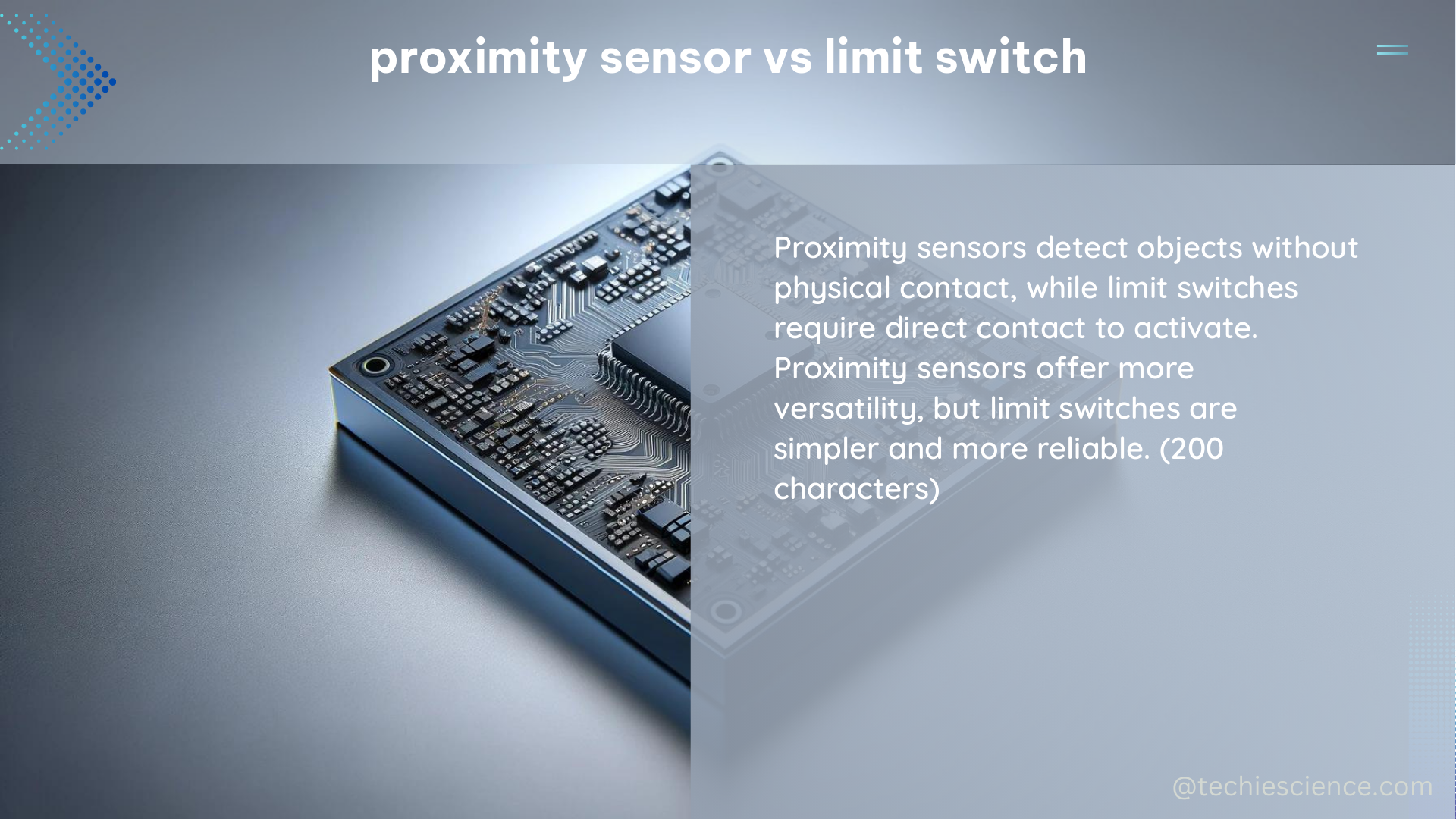Proximity sensors and limit switches are two widely used technologies in various industrial and automation applications. While both devices are designed to detect the presence or absence of an object, they differ in their working principles, detection ranges, accuracy, and environmental factors. This comprehensive guide will delve into the intricacies of proximity sensors and limit switches, providing you with a deep understanding of their capabilities and applications.
Working Principle
Proximity Sensors:
Proximity sensors utilize electromagnetic or infrared radiation to detect the presence or absence of an object without any physical contact. These sensors can be categorized into different types, such as inductive, capacitive, and photoelectric, each with its own unique detection mechanism.
- Inductive Proximity Sensors: These sensors generate an electromagnetic field and detect the presence of a metallic object within the field. The object’s proximity alters the sensor’s oscillating circuit, triggering the output signal.
- Capacitive Proximity Sensors: These sensors detect the change in the sensor’s electrical capacitance caused by the presence of an object, which can be either metallic or non-metallic.
- Photoelectric Proximity Sensors: These sensors use light, typically infrared or visible light, to detect the presence or absence of an object. They can be further classified into different subtypes, such as diffuse, retro-reflective, and through-beam.
Limit Switches:
Limit switches, on the other hand, use mechanical means to detect the position of an object. They consist of a switch mechanism that is physically actuated by the object, causing the switch to make or break an electrical contact. This physical interaction allows limit switches to detect the precise position of an object.
Detection Range and Accuracy

Proximity Sensors:
Proximity sensors have a longer detection range compared to limit switches. Inductive proximity sensors can typically detect metallic objects up to 30mm, while capacitive proximity sensors can detect non-metallic objects up to 15mm. The detection range can be influenced by factors such as the size, material, and shape of the target object, as well as the sensor’s design and configuration.
In terms of accuracy, proximity sensors are generally more precise than limit switches. Since they do not rely on physical contact, proximity sensors can detect the presence or absence of an object with a high degree of accuracy, typically within ±1mm. This eliminates the potential for wear and tear, which can affect the accuracy of limit switches over time.
Limit Switches:
Limit switches have a much shorter detection range, typically up to a few millimeters. This limited range is due to the mechanical nature of their operation, which requires physical contact with the object to be detected. The accuracy of limit switches is generally within ±0.5mm, which is slightly lower than that of proximity sensors.
Environmental Factors
Proximity Sensors:
Proximity sensors are less susceptible to environmental factors such as dust, dirt, and moisture compared to limit switches. Their non-contact design allows them to operate reliably in harsh environments where limit switches may fail due to the accumulation of contaminants. Proximity sensors can withstand a wider range of operating temperatures, typically from -25°C to +70°C.
Limit Switches:
Limit switches are more vulnerable to environmental factors, as their mechanical design can be affected by the presence of dust, dirt, and moisture. The accumulation of these contaminants can interfere with the switch’s operation, leading to false triggers or even complete failure. Limit switches typically have a narrower operating temperature range, typically from -20°C to +70°C.
Technical Specifications
To provide a more detailed comparison, here are the key technical specifications for proximity sensors and limit switches:
Proximity Sensor Specifications:
– Detection range: up to 30mm (inductive) or up to 15mm (capacitive)
– Accuracy: ±1mm
– Operating temperature: -25°C to +70°C
– Response time: <1ms
– Output signal: NPN or PNP transistor, analog voltage or current
Limit Switch Specifications:
– Detection range: up to a few millimeters
– Accuracy: ±0.5mm
– Operating temperature: -20°C to +70°C
– Response time: <10ms
– Output signal: Normally open or normally closed contact
DIY Projects
Building a simple proximity sensor using an Arduino board, an infrared sensor module, and an LED is a great DIY project. By connecting the sensor module to the Arduino and programming it to detect the presence or absence of an object, you can create a basic proximity sensing system that turns on an LED when an object is detected.
Similarly, you can use a limit switch in a DIY project by connecting it to an Arduino board and programming it to detect the position of an object. This can be useful for applications such as end-of-travel detection, limit positioning, or safety interlocks.
Conclusion
Proximity sensors and limit switches are both valuable tools in the world of automation and industrial applications. Understanding the differences between these two technologies is crucial in selecting the right solution for your specific needs. By considering factors such as detection range, accuracy, and environmental resilience, you can make an informed decision and optimize the performance of your systems.
References
- Sensor Technology Handbook – OLLINTEC
- CONTROL VALVE HANDBOOK | Emerson
- Fundamentals of bio-electrochemical sensing – ScienceDirect.com
- NUREG-1959 “Intrusion Detection Systems and Subsystems
- SmartMesh IP Application Notes – Analog Devices

The lambdageeks.com Core SME Team is a group of experienced subject matter experts from diverse scientific and technical fields including Physics, Chemistry, Technology,Electronics & Electrical Engineering, Automotive, Mechanical Engineering. Our team collaborates to create high-quality, well-researched articles on a wide range of science and technology topics for the lambdageeks.com website.
All Our Senior SME are having more than 7 Years of experience in the respective fields . They are either Working Industry Professionals or assocaited With different Universities. Refer Our Authors Page to get to know About our Core SMEs.